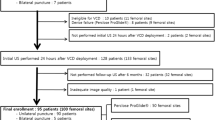Abstract
Purpose
To assess the efficacy and safety of the Exoseal vascular closure device for antegrade puncture of the femoral artery.
Methods
In a prospective study from February 2011 to January 2012, a total of 93 consecutive patients received a total of 100 interventional procedures via an antegrade puncture of the femoral artery. An Exoseal vascular closure device (6F) was used for closure in all cases. Puncture technique, duration of manual compression, and use of compression bandages were documented. All patients were monitored by vascular ultrasound and color-coded duplex sonography of their respective femoral artery puncture site within 12 to 36 h after angiography to check for vascular complications.
Results
In 100 antegrade interventional procedures, the Exoseal vascular closure device was applied successfully for closure of the femoral artery puncture site in 96 cases (96 of 100, 96.0 %). The vascular closure device could not be deployed in one case as a result of kinking of the vascular sheath introducer and in three cases because the bioabsorbable plug was not properly delivered to the extravascular space adjacent to the arterial puncture site, but instead fully removed with the delivery system (4.0 %). Twelve to 36 h after the procedure, vascular ultrasound revealed no complications at the femoral artery puncture site in 93 cases (93.0 %). Minor vascular complications were found in seven cases (7.0 %), with four cases (4.0 %) of pseudoaneurysm and three cases (3.0 %) of significant late bleeding, none of which required surgery.
Conclusion
The Exoseal vascular closure device was safely used for antegrade puncture of the femoral artery, with a high rate of procedural success (96.0 %), a low rate of minor vascular complications (7.0 %), and no major adverse events.
Similar content being viewed by others
References
Katz SG, Abando A (2004) The use of closure devices. Surg Clin North Am 84:1267–1280
Schwartz BG, Burstein S, Economides C et al (2010) Review of vascular closure devices. J Invasive Cardiol 22:599–607
Cordis (2011) Instructions for use: Cordis Exoseal vascular closure device. Cordis Corporation, Miami Lakes
Wong CW, Bachinsky W, Cambier P; for the ECLIPSE Trial Investigators et al (2009) A randomized comparison of a novel bioabsorbable vascular closure device versus manual compression in the achievement of hemostasis after percutaneous femoral procedures: the ECLIPSE trial (Ensure’s Vascular Closure Device Speeds Hemostasis trial). JACC Cardiovasc Interv 2:785–793
Minko P, Katoh M, Gräber S, Buecker A (2012) Obesity: an independent risk factor for insufficient hemostasis using the AngioSeal vascular closure device after antegrade puncture. Cardiovasc Intervent Radiol 35:775–778
Reekers JA, Müller-Hülsbeck S, Libicher M et al (2011) CIRSE vascular closure device registry. Cardiovasc Intervent Radiol 34:50–53
Lupattelli T, Tannouri F, Garaci FG et al (2010) Efficacy and safety of antegrade common femoral artery access closure using the Angio-Seal device: experience with 1889 interventions for critical limb ischemia in diabetic patients. J Endovasc Ther 17:366–375
Looby S, Keeling AN, McErlean A et al (2008) Efficacy and safety of the AngioSeal vascular closure device post antegrade puncture. Cardiovasc Intervent Radiol 31:558–562
Kapoor B, Panu A, Berscheid B (2007) Angio-Seal in antegrade endovascular interventions: technical success and complications in a 55-patient series. J Endovasc Ther 14:382–386
Biondi-Zoccai GG, Fusaro M, Tashani A et al (2007) AngioSeal use after antegrade femoral arteriotomy in patients undergoing percutaneous revascularization for critical limb ischemia: a case series. Int J Cardiol 118:398–399
Mukhopadhyay K, Puckett MA, Roobottom CA (2005) Efficacy and complications of AngioSeal in antegrade puncture. Eur J Radiol 56:409–412
Wille J, Vos JA, Overtoom TT et al (2006) Acute leg ischemia: the dark side of percutaneous femoral artery closure device. Ann Vasc Surg 20:278–281
Chiu AH, Vander Wal R, Tee K et al (2008) Comparison of arterial closure devices in antegrade and retrograde punctures. J Endovasc Ther 15:315–321
Duda SH, Wiskirchen J, Erb M et al (1999) Suture-mediated percutaneous closure of antegrade femoral arterial access sites in patients who have received full anticoagulation therapy. Radiology 210:47–52
Hahn U, Betsch A, Wiskirchen J et al (2001) A new device for percutaneous suture-mediated closure of arterial puncture sites using exteriorized needles: initial experience. J Invasive Cardiol 3:456–459
Spiliopoulos S, Katsanos K, Karnabatidis D et al (2011) Safety and efficacy of the starclose vascular closure device in more than 1000 consecutive peripheral angioplasty procedures. J Endovasc Ther 18:435–443
Chiu AH, Coles SR, Tibballs J, Nadkarni S (2010) The StarClose vascular closure device in antegrade and retrograde punctures: a single-center experience. J Endovasc Ther 17:46–50
Fantoni C, Medda M, Mollichelli N et al (2008) Clip-based arterial haemostasis after antegrade common femoral artery puncture. Int J Cardiol 128:427–429
Conflict of interest
D. Vorwerk received payment for lectures from Cook Group Incorporated, ev3, W. L. Gore & Associates, Inc., C. R. Bard, Inc., and Cordis Corporation. He also received payment for development of educational presentations from Cook Group Incorporated, ev3, W. L. Gore & Associates, Inc., C. R. Bard, Inc., Cordis Corporation, and BSIC, Inc. The other authors declare that they have no conflict of interest.
Author information
Authors and Affiliations
Corresponding author
Rights and permissions
About this article
Cite this article
Schmelter, C., Liebl, A., Poullos, N. et al. Suitability of Exoseal Vascular Closure Device for Antegrade Femoral Artery Puncture Site Closure. Cardiovasc Intervent Radiol 36, 659–668 (2013). https://doi.org/10.1007/s00270-012-0501-2
Received:
Accepted:
Published:
Issue Date:
DOI: https://doi.org/10.1007/s00270-012-0501-2




